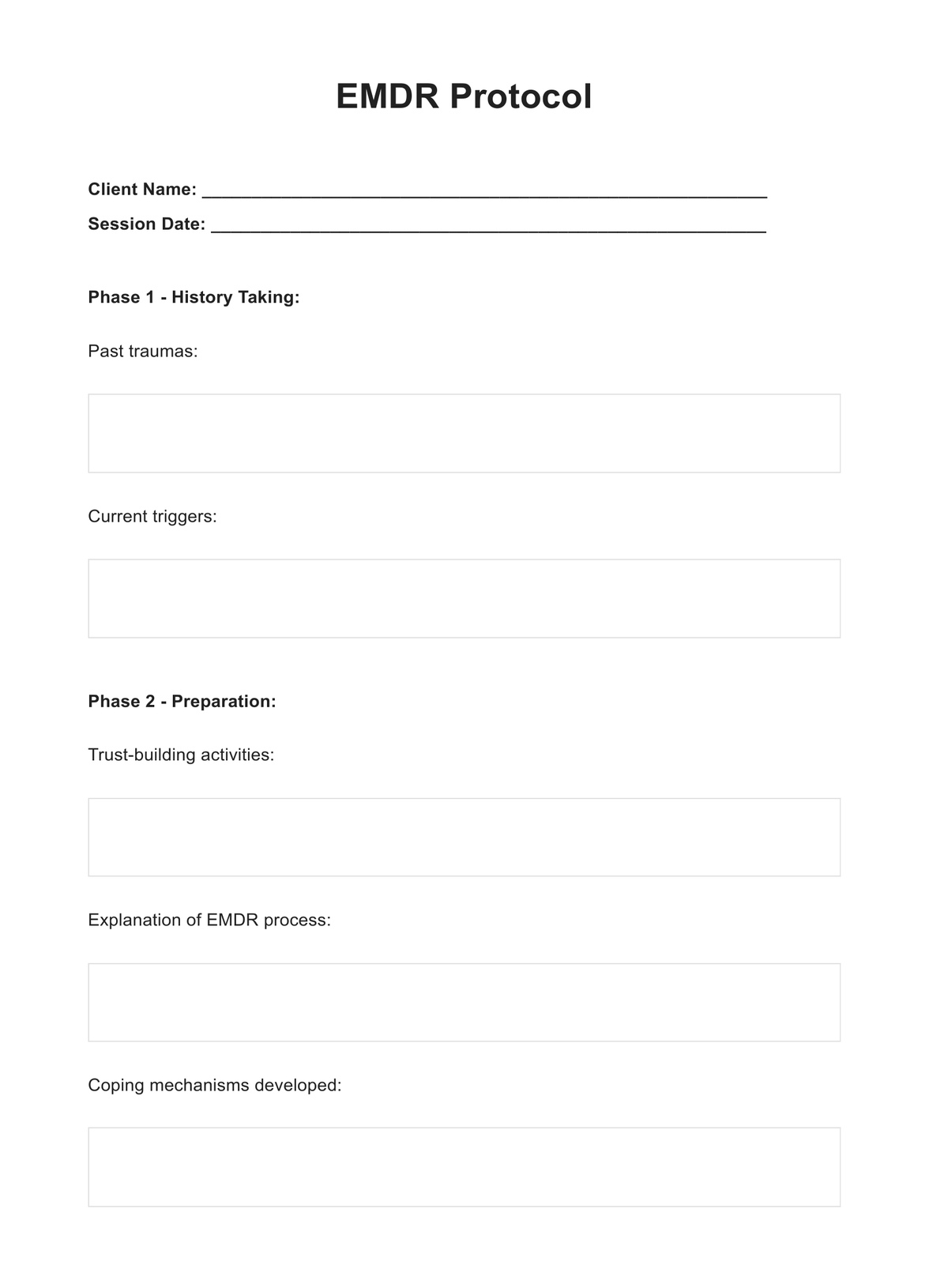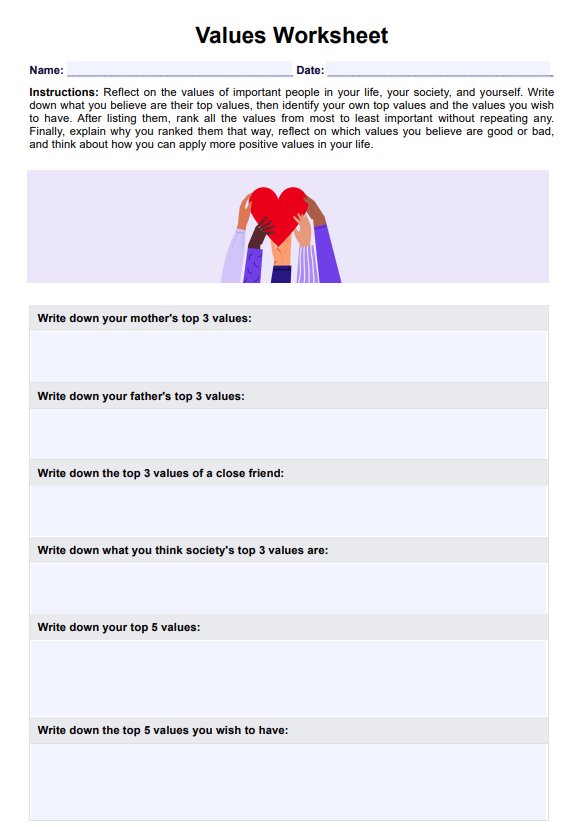Burnout Recovery Plan
Get your free PDF of a burnout recovery plan from Carepatron to help you overcome burnout and regain work-life balance. Explore practical recovery strategies.


What is burnout?
Burnout is a multifaceted phenomenon that affects individuals physically and mentally. It often stems from prolonged exposure to chronic stressors, particularly in the workplace. It's more than just feeling tired or overwhelmed; it's a state of profound emotional exhaustion and diminished interest or effectiveness in one's work or daily activities.
At its core, burnout represents a significant imbalance between the demands placed on an individual and the resources available to cope with those demands. This imbalance can result in detrimental effects on both physical and mental health, impacting overall well-being and productivity.
Job burnout isn't a fleeting feeling of stress, but rather a persistent state that can have serious consequences if left unaddressed. It can manifest in various ways, including cynicism, detachment from work, and a sense of ineffectiveness or lack of accomplishment.
Recognizing the signs of burnout is crucial for implementing effective strategies to manage stress and prevent its escalation into severe burnout. Prioritizing self-care, maintaining a healthy work-life balance, and seeking support from friends, family members, or professionals are essential steps in mitigating the impact of burnout.
Stages of burnout
Understanding the stages of burnout can help individuals recognize its onset and take proactive steps toward recovery. The Oldenburg Burnout Inventory, a widely used tool for assessing burnout, identifies three main stages:
- Stage 1: Exhaustionsome text
- Physical and emotional exhaustion characterize this initial stage.
- Individuals may feel drained, fatigued, and emotionally depleted.
- Energy levels decline, making coping with daily tasks and responsibilities challenging.
- Stage 2: Cynicism and detachmentsome text
- As burnout progresses, individuals may develop negative attitudes towards work and other aspects of their lives.
- Cynicism towards colleagues, clients, or the work itself may emerge.
- Feelings of detachment and disengagement become more pronounced, leading to isolation.
- Stage 3: Reduced accomplishment and efficacysome text
- In the final stage of burnout, individuals may experience a significant decline in their sense of accomplishment and efficacy.
- They may feel incompetent, ineffective, and unable to meet their goals or expectations.
- Performance at work and in other areas of life may suffer.
Burnout Recovery Plan Template
Burnout Recovery Plan Example
Causes of burnout
Burnout does not happen in an instant. There are always triggers or underlying factors that contribute to its development. Here are some causes of burnout that individuals may want to look out for:
- Workload and job demands: Research suggests that excessive workload and high job demands significantly contribute to burnout. When overwhelmed with tasks and responsibilities, individuals may struggle to maintain a healthy life balance, leading to increased stress and fatigue.
- Lack of control: Feeling a lack of control over one's work environment or schedule can contribute to feelings of frustration and helplessness, exacerbating stress levels and increasing the risk of burnout. Having autonomy and decision-making authority can help mitigate this risk.
- Workplace culture and environment: A toxic work environment characterized by poor communication, lack of support, and conflict can significantly impact employee well-being and contribute to burnout. Cultivating a positive workplace culture that values employee health and well-being is essential for preventing burnout.
- Poor work-life balance: Many individuals struggle to maintain a healthy balance between work and personal life in today's fast-paced world. Long hours, overtime, and the inability to disconnect from work can take a toll on physical and mental health, leading to burnout.
- Lack of recognition and reward: Feeling undervalued and unappreciated for one's contributions can erode morale and motivation, increasing the risk of burnout. Recognizing and rewarding employees for their hard work and achievements is crucial for fostering a positive work environment.
- Unclear expectations and role ambiguity: When individuals are unsure of what is expected of them or their role within the organization, it can lead to confusion, stress, and feelings of inadequacy. Clear communication and role clarity are essential for preventing burnout and promoting employee well-being.
Burnout symptoms and signs
Identifying the symptoms and signs of burnout is crucial for early intervention and prevention. Burnout can manifest differently in individuals, but there are common indicators to watch for. Let's explore some of the key symptoms and signs:
- Physical symptoms: Chronic fatigue, frequent illness, headaches, and muscle pain are common physical indicators of burnout. Individuals may feel persistently tired, experience tension headaches or migraines, and have general body aches and stiffness.
- Emotional symptoms: Depersonalization, detachment, reduced sense of accomplishment, and cynicism are emotional signs of burnout. Individuals may feel emotionally disconnected from their work, struggle to find satisfaction in their accomplishments, and exhibit a negative outlook towards life.
- Behavioral symptoms: Withdrawal from social activities, isolation, decreased performance, and increased substance use are behavioral indicators. Individuals may avoid social interactions, struggle to concentrate or meet deadlines, and turn to substances as a coping mechanism.
How to recover from burnout?
Recovering from burnout requires a comprehensive approach addressing physical and emotional well-being. Here are some effective strategies to help individuals navigate the path to recovery:
Prioritize self-care
Engage in activities promoting relaxation and rejuvenation, such as meditation, yoga, or leisure time in nature. Ensure adequate sleep, nutrition, and hydration to support physical health and energy levels. Set boundaries to protect personal time and avoid over-committing to work or other obligations.
Seek support
Contact friends, family members, or colleagues for emotional support and encouragement. Consider seeking professional help from a therapist or counselor who manages stress and employee burnout recovery. Join support groups or online communities where individuals going through burnout can share their experiences and learn from others.
Practice stress management techniques
Learn and utilize techniques to prevent burnout, such as deep breathing exercises, progressive muscle relaxation, or mindfulness meditation. Incorporate regular exercise into your routine to release tension, boost mood, and improve overall well-being. Identify and address sources of stress in your life, whether related to work, relationships, or other areas, and develop healthy coping strategies to manage them effectively.
Restore work-life balance
Evaluate your current workload and commitments and adjust to create a more balanced schedule. Set boundaries around work hours and avoid bringing work home whenever possible. Make time for leisure activities, hobbies, and social connections to foster a sense of fulfillment and joy outside of work.
Set realistic expectations
Manage perfectionistic tendencies by setting realistic goals and expectations for yourself. Recognize that it's okay to ask for help or delegate tasks when necessary and that you don't have to do everything independently. Focus on progress rather than perfection and celebrate small victories along the way.
What is a Burnout Recovery Plan?
A burnout recovery plan is a structured framework designed to help individuals overcome burnout and regain a sense of balance and well-being in their lives. It involves identifying the factors contributing to burnout, implementing strategies to reduce stress and restore energy levels, and setting realistic goals for recovery. This can be used after taking the burnout test.
A well-designed recovery plan addresses various aspects of an individual's life, including work responsibilities, personal commitments, and self-care practices. It may include interventions such as stress management techniques, changes in work habits or schedules, and seeking support from friends, family, or professionals.
While the length of recovery may vary depending on the severity of burnout and individual circumstances, a comprehensive recovery plan provides a roadmap for navigating the process and building towards a more fulfilling life.
Employees can recover from burnout by dedicating time and effort to their recovery plan and cultivating a healthier and more sustainable approach to work and life.
What is in the plan?
A burnout recovery plan encompasses various strategies and interventions aimed at addressing the underlying causes of burnout and promoting overall well-being.
Let's delve into the key components typically included in such a plan:
- Assessment of burnout symptoms
- Identifying triggers and stressors
- Setting realistic goals
- Imprelementing stress management techniques
- Creating work-life balance
- Seeking support
- Engaging in self-care practices
- Monitoring progress and adjusting the plan
How to use the template?
Carepatron's burnout recovery plan template is designed to guide individuals through the process of overcoming burnout and reclaiming balance in their lives. Here are the steps on how to effectively use the template:
- Download the template: Access the Burnout Recovery Plan Template from the provided link to the Resource Library or through Carepatron's app.
- Assess patient symptoms: Utilize the provided questionnaire or assessment tool to evaluate the severity of your patient's burnout symptoms, identifying triggers and stressors.
- Set patient-centric goals: Based on the assessment results, work with your patient to establish realistic and achievable recovery goals, considering their personal and professional obligations.
- Develop a customized plan: Utilize the strategies outlined in the template to create a personalized recovery plan. Incorporate stress management techniques, self-care practices, and support systems tailored to your patient's needs.
- Explain the plan to the patient: Ensure that your patient understands the recovery plan. Discuss the importance of each step and how they can actively participate in their recovery process.
- Monitor and adjust: Regularly review your patient's progress and adjust the plan as necessary to accommodate changes in their symptoms or circumstances.
Benefits of having a Burnout Recovery Plan
Implementing a burnout recovery plan offers numerous advantages that can significantly impact individuals' well-being and productivity. Let's explore some of the key benefits:
Proactive approach to combat burnout
A burnout recovery plan enables individuals to take a proactive approach to combat burnout before it escalates. By identifying triggers and stressors early on, individuals can implement strategies to mitigate their impact and prevent burnout.
Enhanced stress management
A structured recovery plan equips individuals with effective stress management techniques, such as mindfulness and relaxation exercises. These techniques help individuals cope with stressors more effectively and reduce the risk of burnout.
Improved energy levels and productivity
Individuals can replenish their energy levels and restore productivity by prioritizing self-care and setting boundaries. This leads to better work performance and a greater sense of fulfillment in daily activities.
Quicker recovery time
Having a structured recovery plan can expedite the recovery process from burnout. By following a systematic approach and implementing targeted interventions, individuals can recover more efficiently and return to balance and well-being.
Empowerment and confidence
Implementing a burnout recovery plan empowers individuals to take control of their well-being and build resilience in adversity. This sense of empowerment boosts confidence and enables individuals to navigate stressful situations more effectively.
Prevention of recurrence
By addressing underlying causes and implementing preventive measures, a burnout recovery plan reduces the likelihood of burnout recurrence. Individuals learn to recognize early warning signs and implement strategies to maintain balance and well-being over the long term.
Commonly asked questions
Recovery time varies depending on individual circumstances but may range from weeks to months. Consistently implementing self-care strategies and seeking professional support can expedite the recovery process.
Burnout recovery typically involves phases of recognition, intervention, and maintenance. Recognizing symptoms, implementing coping strategies, and maintaining healthy habits are key components of each phase.
The best way to recover from burnout involves a holistic approach addressing physical, emotional, and psychological aspects. Prioritizing self-care, seeking support, and making lifestyle adjustments are effective strategies.


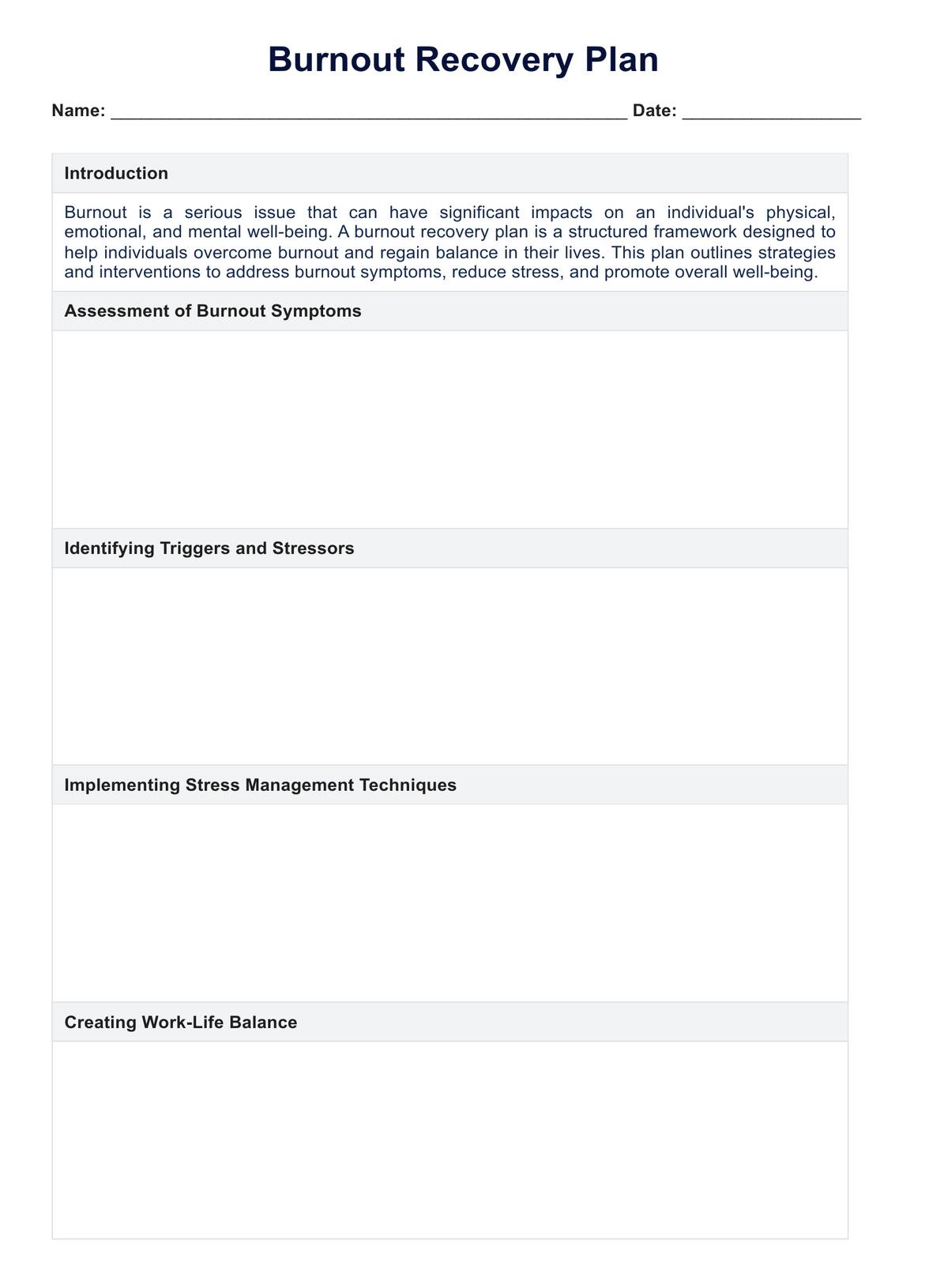
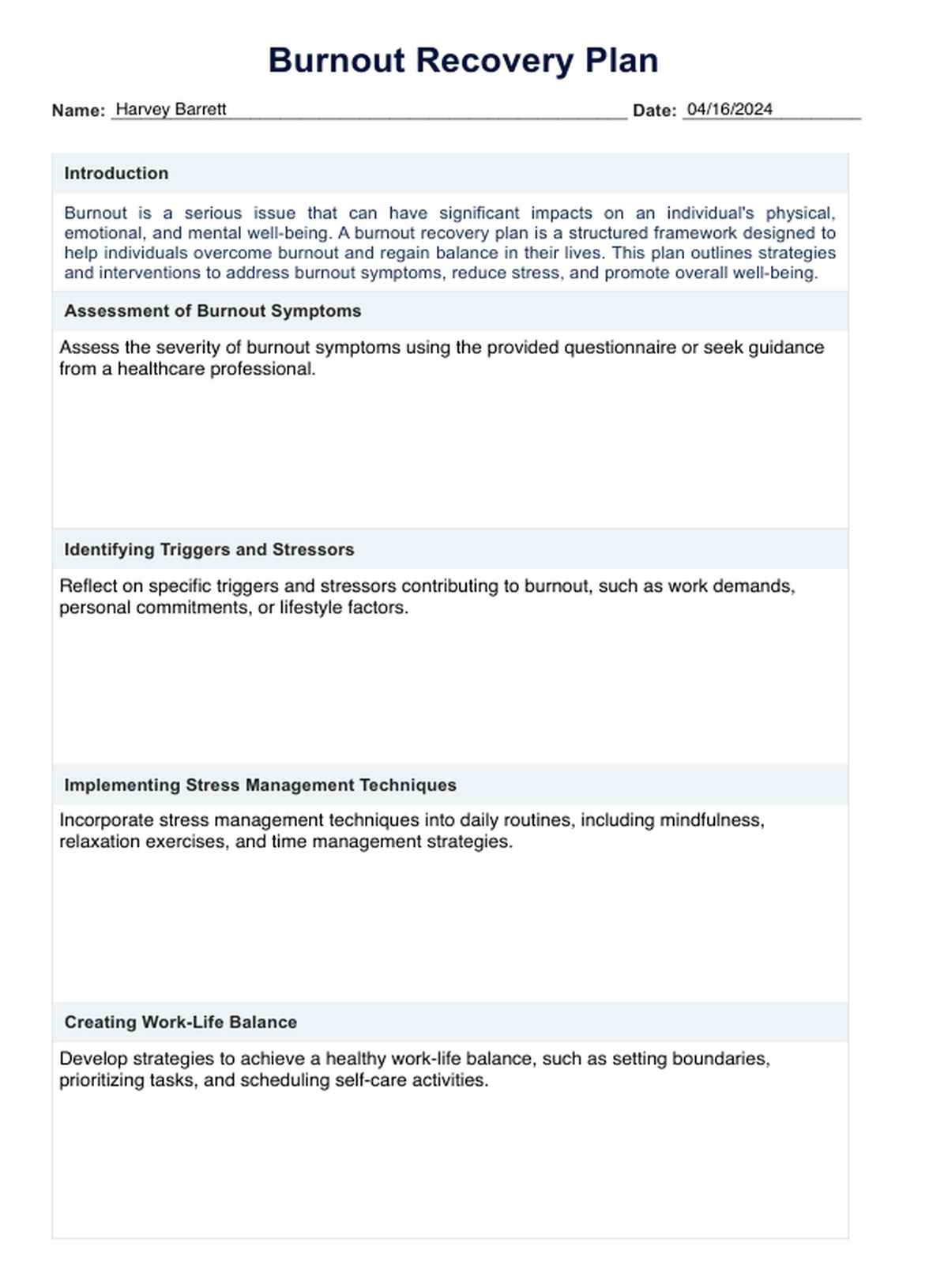

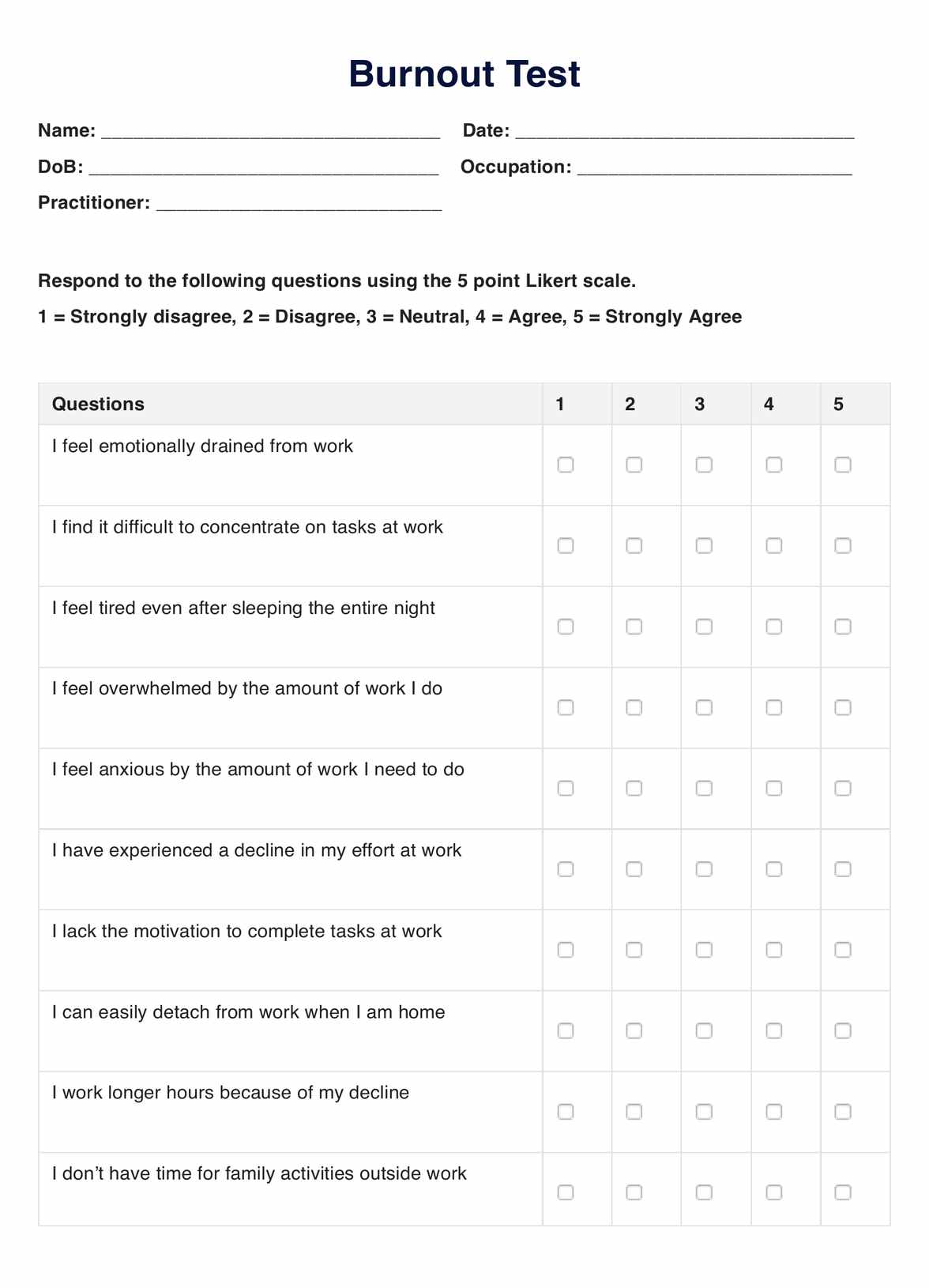
















-template.jpg)



























































































